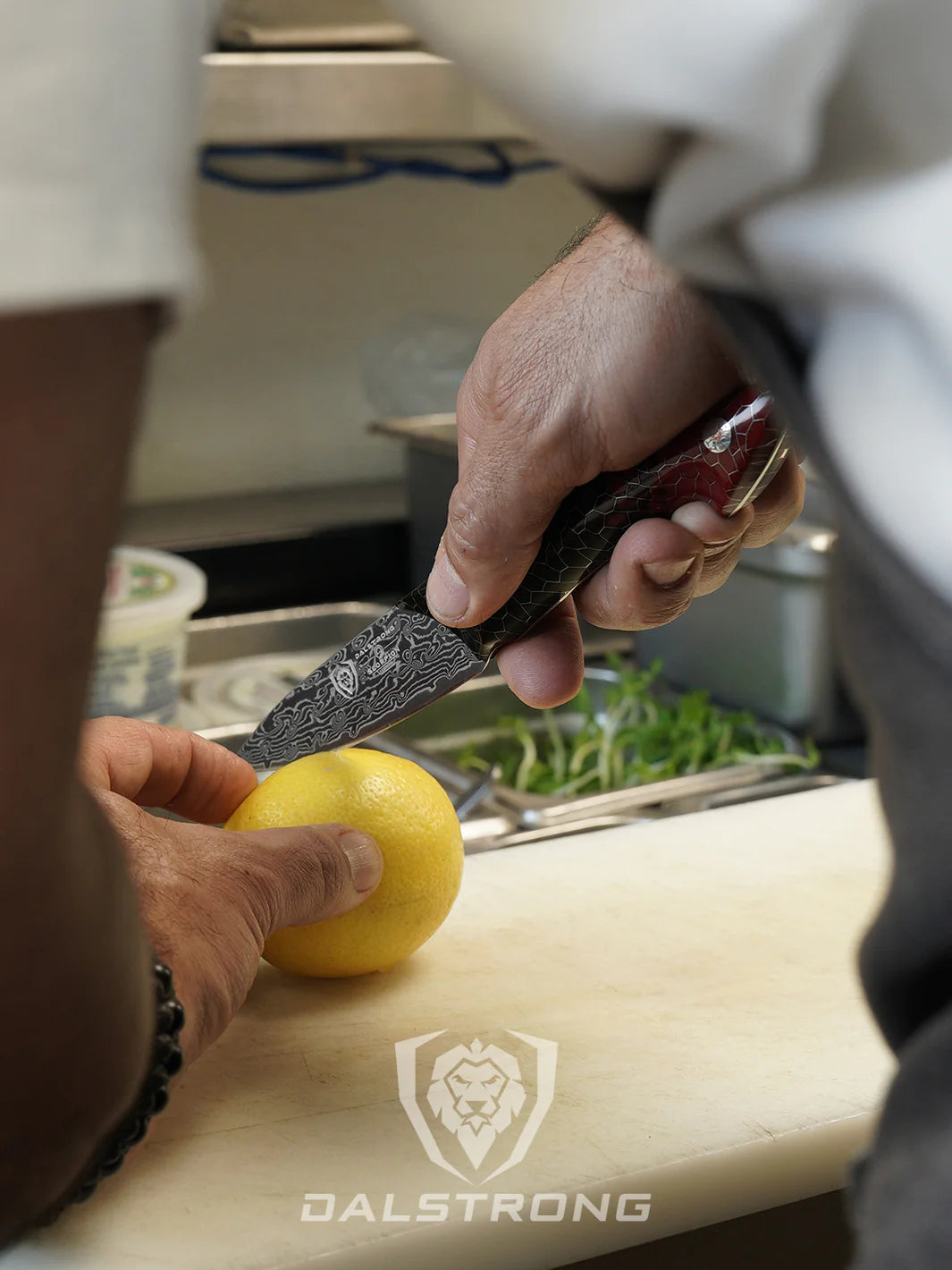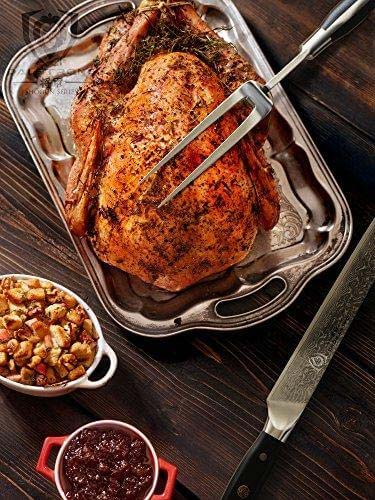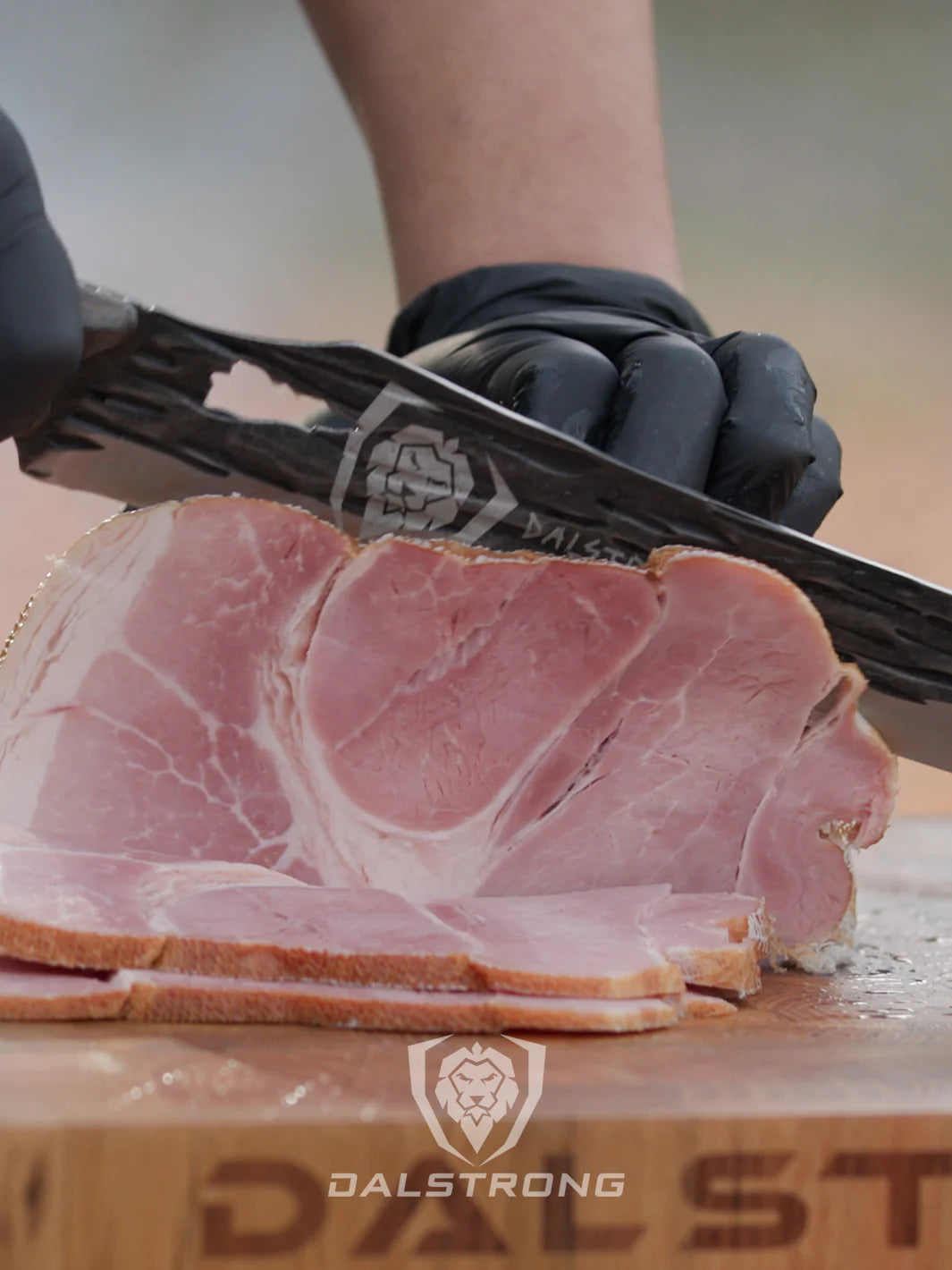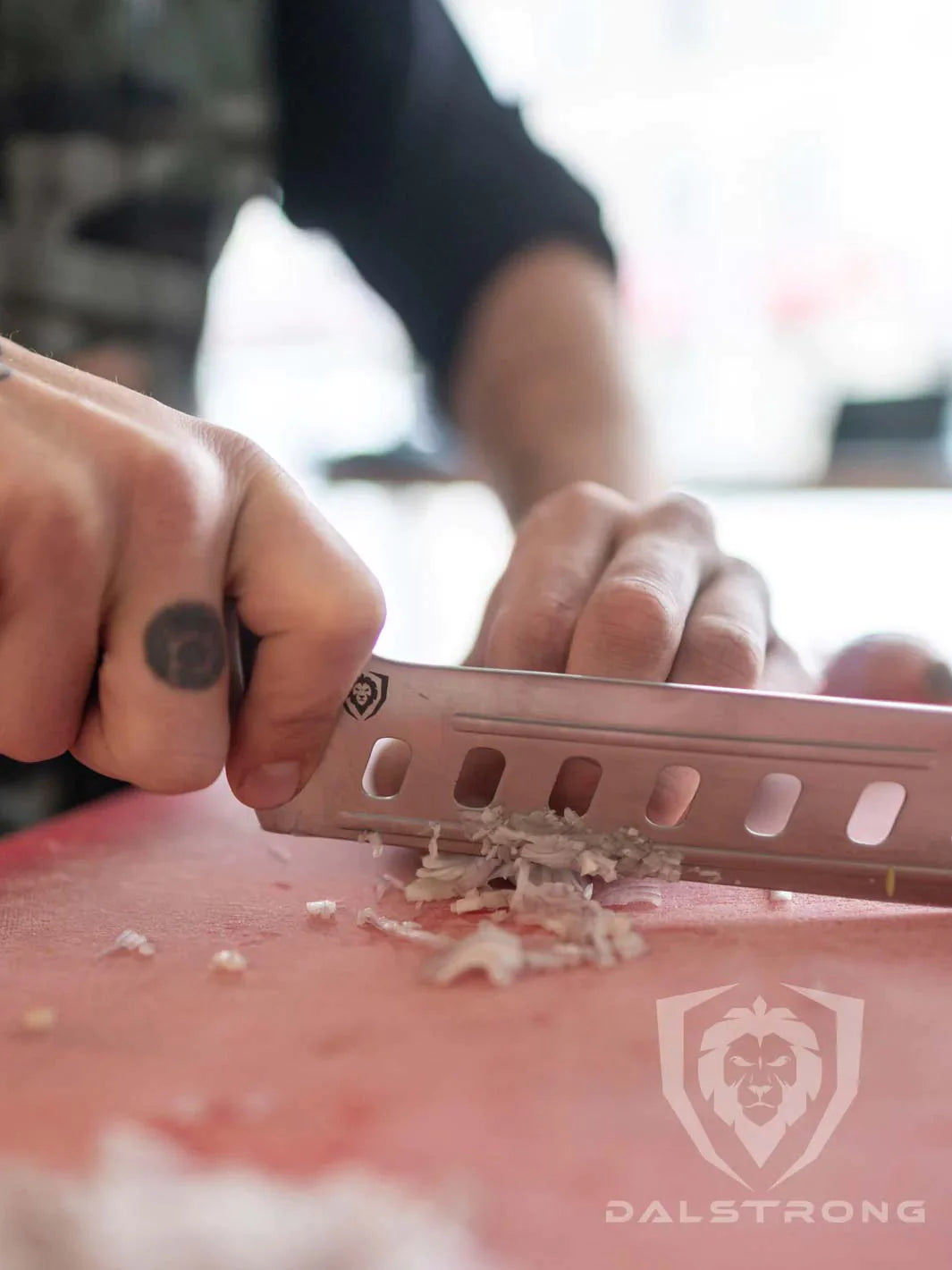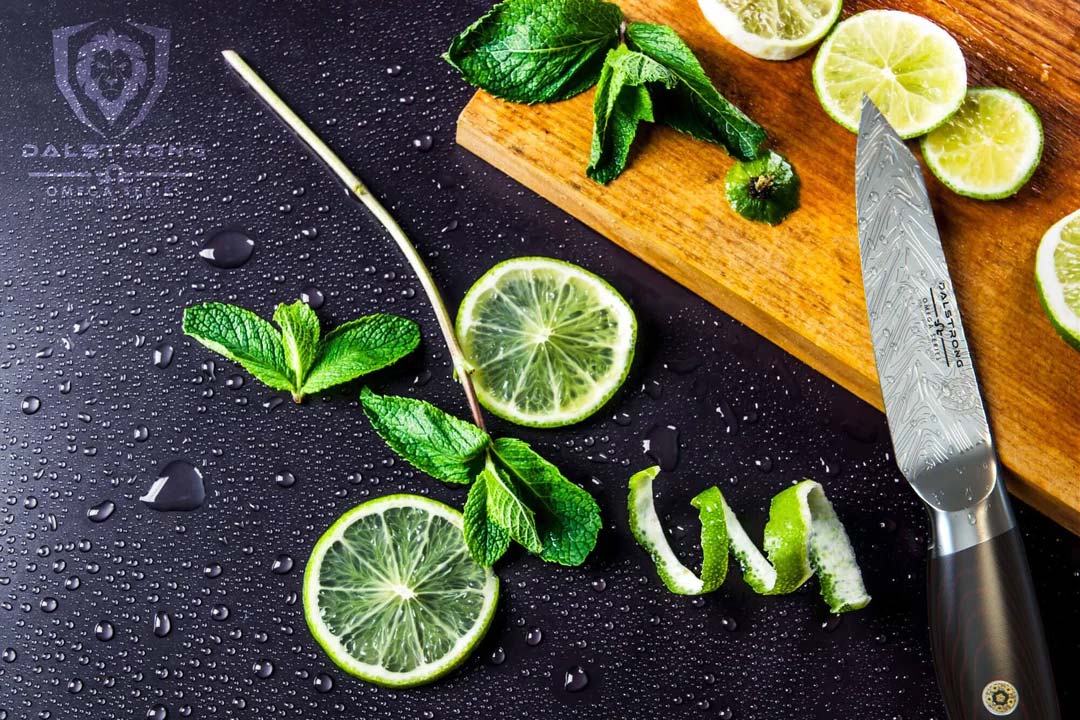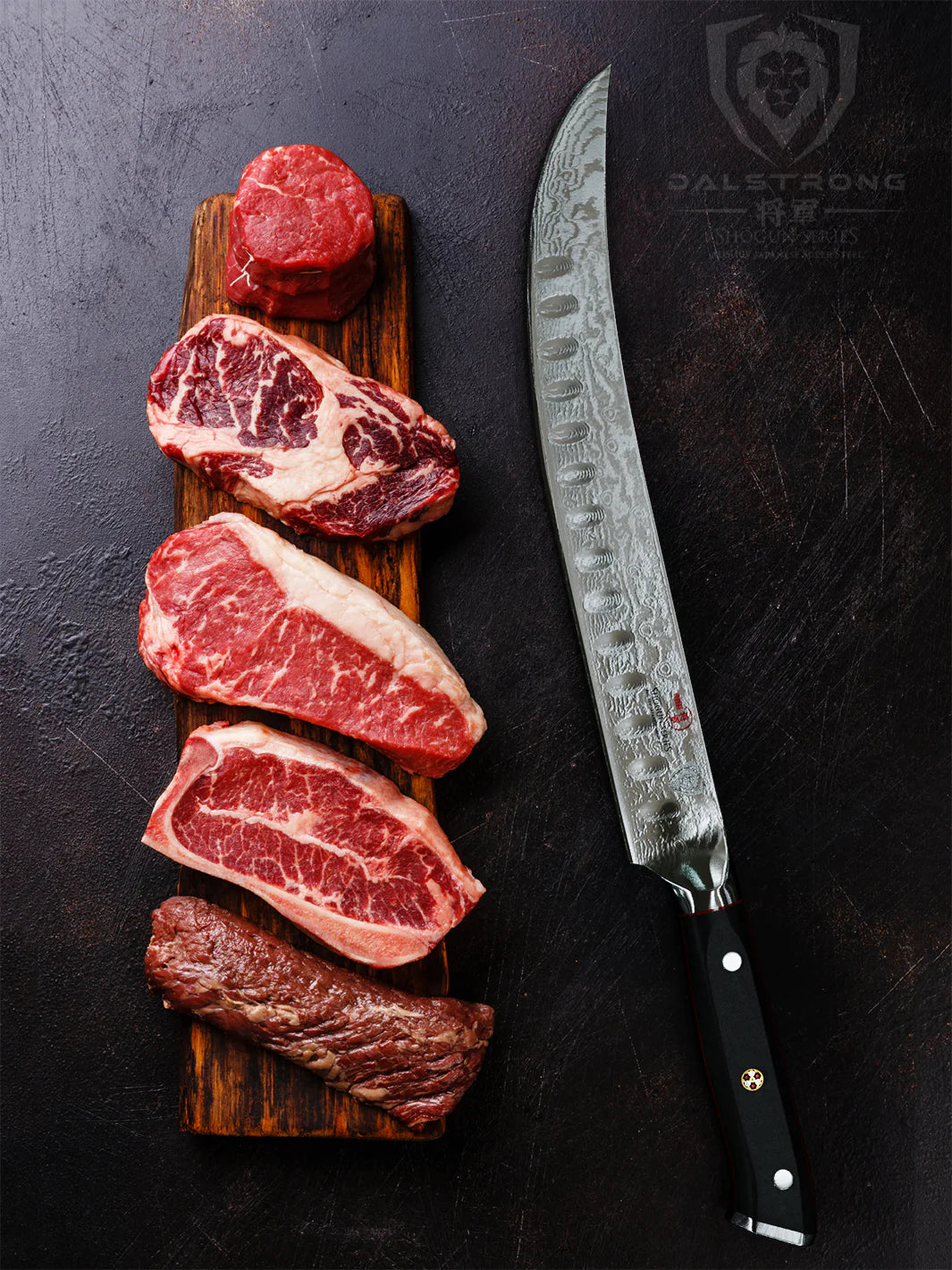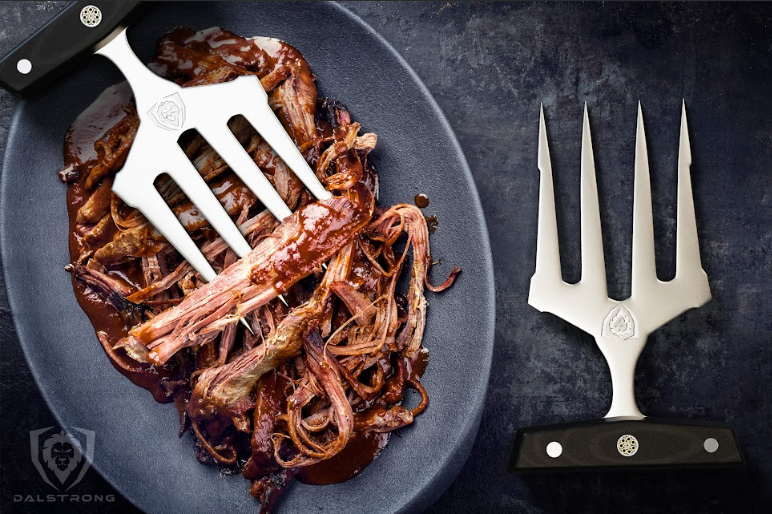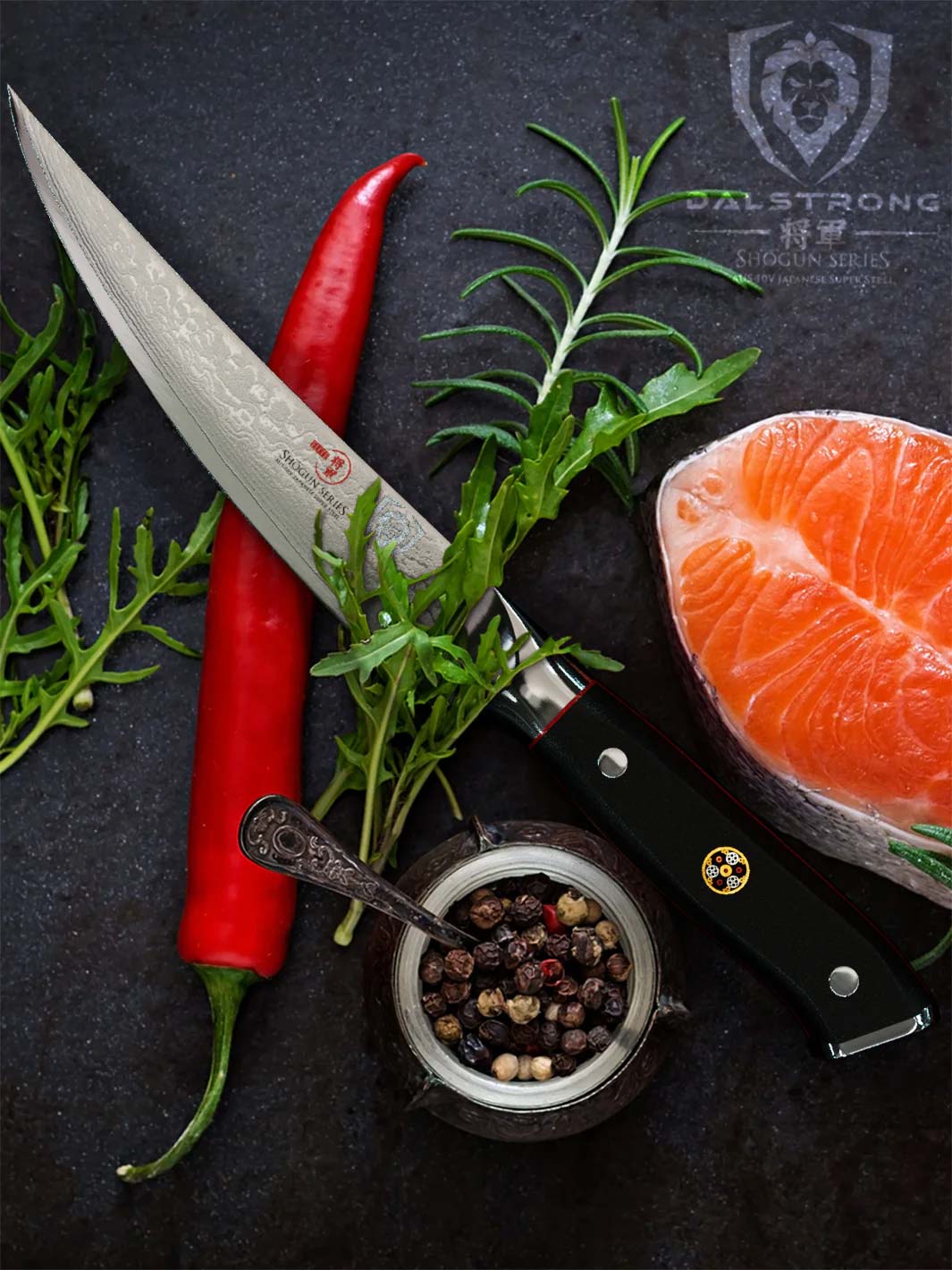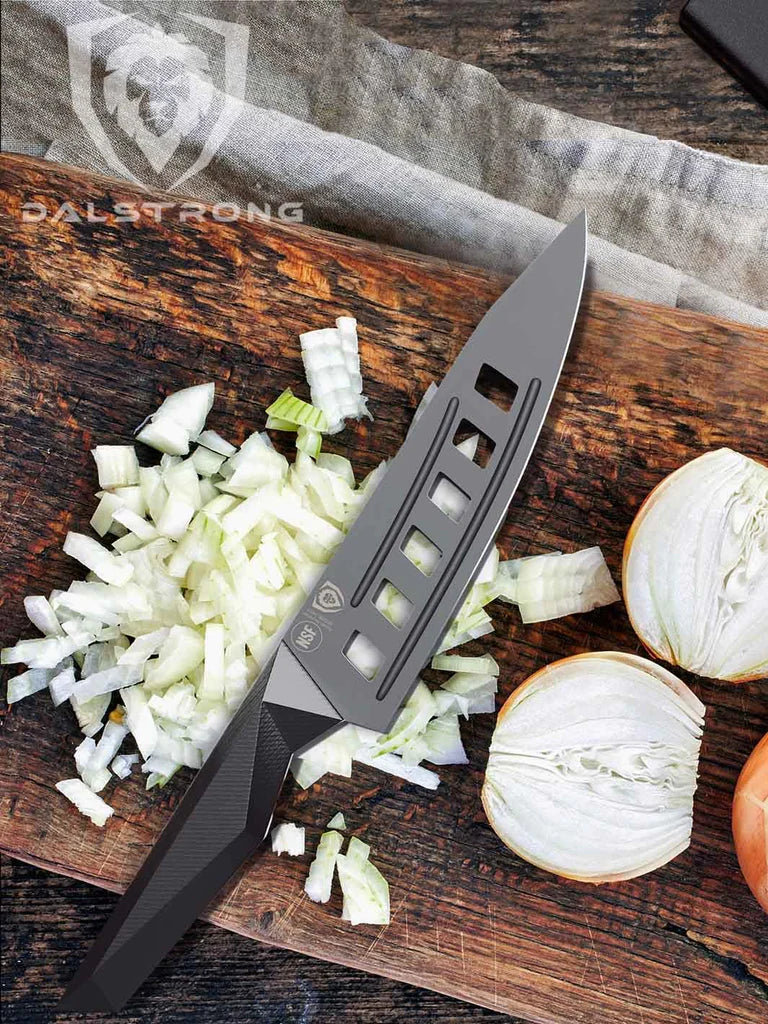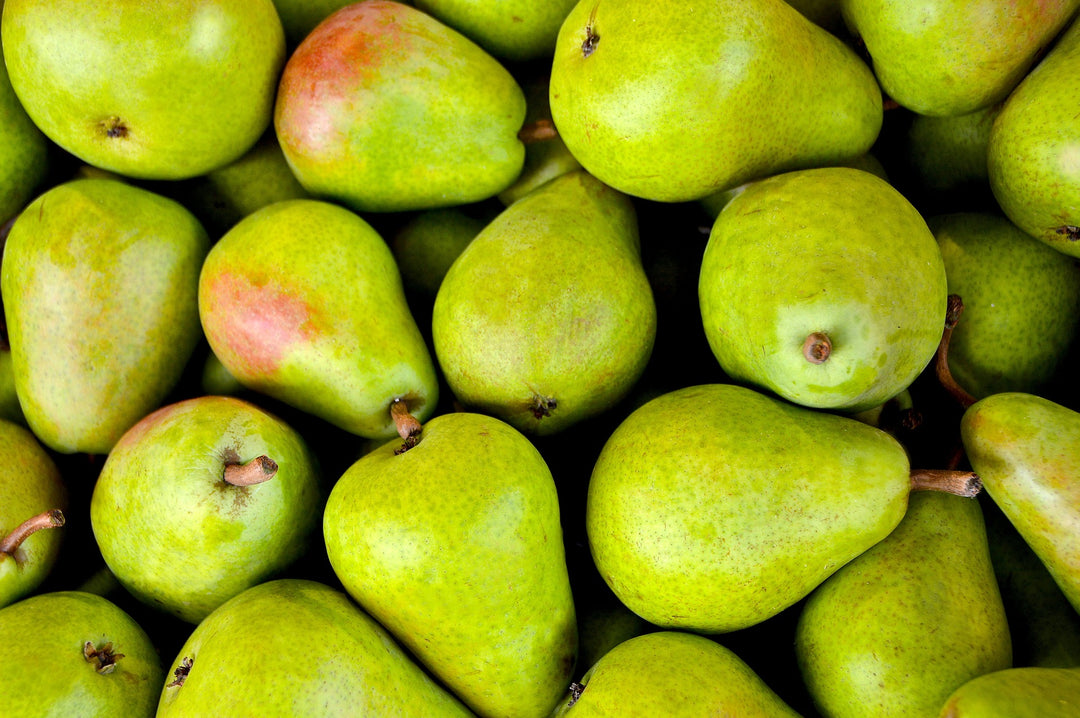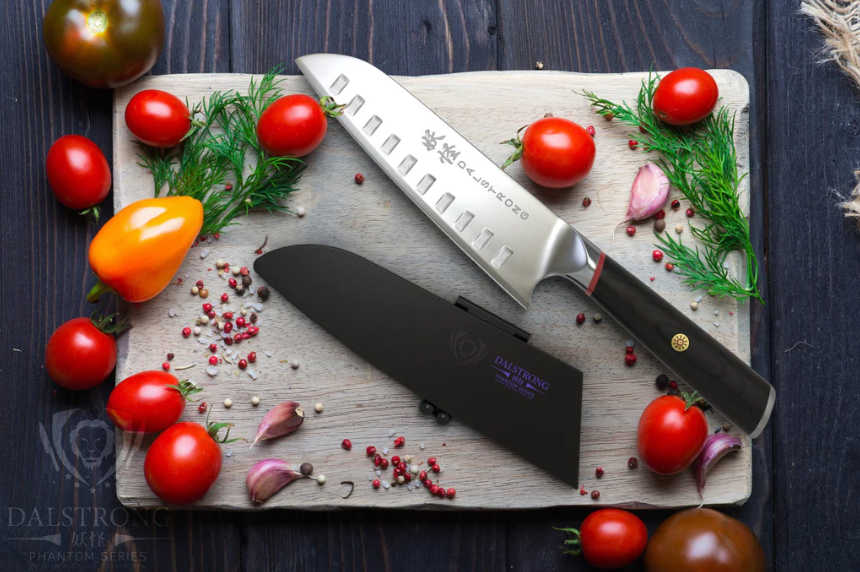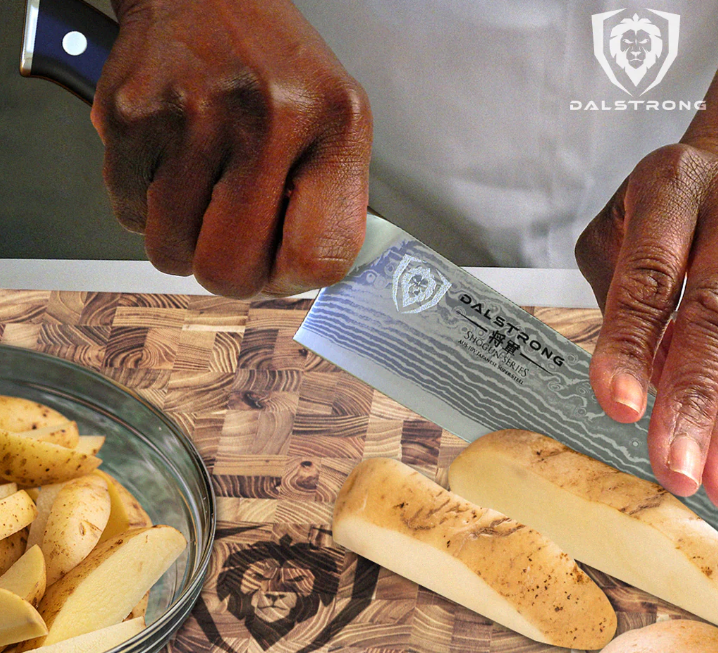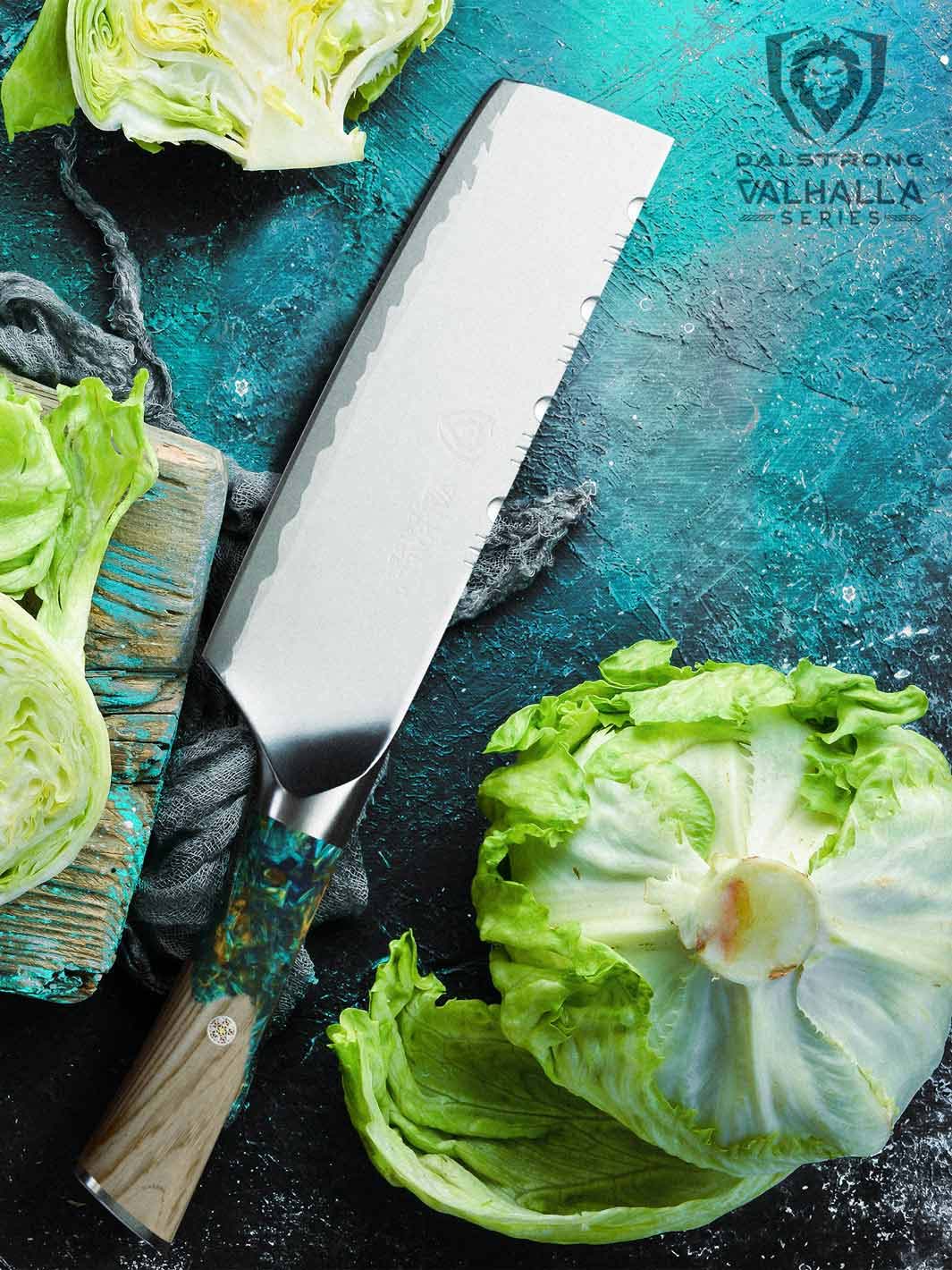All You Ever Wanted to Know About the Serbian Chef Knife
Shogun Series ELITE Serbian Chef's Knife 8"
Serbian chef’s knives are incredibly powerful kitchen knives that resemble a traditional cleaver. They have great edge retention and an incredibly tough build, making them very easy to look after.
1. What is a Serbian Chef Knife?
Serbian Chef's Knife 8" | Shogun Series | Dalstrong
You know all about the chef’s knife (also sometimes confusingly referred to as a “chef knife”). By now, you’re aware that it’s the ultimate multi-purpose tool, being used for all sorts of tasks – from breaking down large cuts of meat into smaller portions, to chopping, slicing, dicing, and mincing various fruits and vegetables.
That’s the thing about chef’s knives: they don’t exactly excel at one particular kitchen task, but they can handle almost anything with aplomb. Whether the task is small or large, you know that a chef’s knife is probably going to do a pretty good job at it. For some home cooks, it’s sometimes the only kitchen knife they need.
So it stands to reason that as one of the most essential kitchen knives, there would be various versions of the famous chef’s knife. Sometimes this is because someone decided to put a fresh spin on an old standard, and sometimes it’s simply a matter of parallel thinking – similar knives sharing similar uses and design elements popping up concurrently through various regions across the globe.
For instance, in Japan you have the Gyuto, the Japanese version of the Western-style chef’s knife, which takes design elements from its German counterpart but gives them a thinner blade, a harder steel, and a double bevel. Staying within Japan, you also have the Santoku, another famous multi-purpose knife that many have compared to a Western chef’s knife.
Famously, there are also French-style chef’s knives, which have straighter edges that curve up to the tip, and Chinese chefs knives which resemble a cleaver but are used as all-purpose tools.
But one of the most surprisingly overlooked variations of the chef knife is known as the Serbian Chef Knife (or Serbian Steel Chef’s Knife). I say “surprisingly overlooked” because this is a version of a chef’s knife that packs so much power and is so useful for so many different kitchen tasks, that it’s a wonder it didn’t become more widely known like some of the other variations.
In fact, while Serbian chef’s knives have long fallen out of style and become mostly forgotten by modern-day chefs, there has been a slow but steady resurgence in popularity among both novice and professional chefs. There is buzz building around the Serbian chef’s knife again, almost like an old-school rock band building up to a late-career comeback.
So what is the Serbian chef knife? There’s actually a bit of mystery around exactly where it came from (we’ll discuss that a little further down), but traditionally, a Serbian chef knife is understood as a blade heralding from Serbia that has a unique shape, sort of like what would happen if you crossed a traditional western-style chef’s knife with a meat cleaver. It is a wide blade with the tip cut off at an angle.
It looks intimidating, and it tends to be quite hefty, giving it an all-around aura of power and menace. Indeed, the Serbian chef’s knife can seem intimidating to anyone who is unaccustomed to its specific design. But that’s what we’re here for: to get you acquainted with this utterly unique kitchen powerhouse. Still want to know more? Check out this blog on the difference between a Serbian Chef's knife and a Chinese cleaver.
In terms of size, the Serbian chef’s knife is usually between 6-12” long. And since it’s typically made of high carbon steel, it has tremendous edge retention, usually requiring very little upkeep. This makes them a very low-maintenance knife, ideal for someone who hasn’t quite figured out how to sharpen a knife with a stone (though to be honest this is a pretty basic kitchen skill you should look into).
So what is driving this Serbian chef’s knife resurgence?
Key advantages of a Serbian chef’s knife:
-
They’re versatile. Because of their shape and size, Serbian chef’s knives can be used for a wide array of kitchen tasks, including some that traditional chef’s knives wouldn’t be quite well suited for. Use these for the usual tasks like chopping, slicing, dicing, mincing, etc.; but also for food transportation, for crushing garlic, and for applying pressure, as well as other tasks that take advantage of its surface area.
-
They’re extremely strong. Serbian chef knives are traditionally hand forged using ancient blacksmithing techniques and high carbon steel, giving them a rigidity and density that makes them some of the sturdiest knives you can buy.
-
They hold their edge very well. This comes down to the type of steel that is used to build them. High carbon steel leads to great edge retention, making the Serbian chef’s knife a fantastic tool for those who may not be huge fans of having to very closely look after your kitchen tools.
- They’re very precise. You wouldn’t expect this from a knife this size (and especially from a knife this heavy), but Serbian chef’s knives are even more precise than a standard chef’s knife. This is because of the knife’s build and balance, which makes it very easy to carry and to work with.
2. A Brief History of the Serbian Chef Knife
Gather round, children, and hear the tale of the origin of the noble Serbian chef’s knife. A tale of heroism and innovation. A tale of courage and adventure. A tale of… hazy memories, half-remembered anecdotes, and conflicting recollections.
Yeah. As it turns out, there’s not a lot of information out there about where the Serbian chef’s knife actually came from. At least no hard data – there’s a lot of speculation, conjecture, and wild guessing. At the very least, there seems to be some sort of vague consensus that the name “Serbian chef’s knife” is appropriate as it actually hails from the landlocked Balkan country.
One name that keeps popping up is Almazan. Almazan Kitchen is a Serbia-based knifemaker that is credited for popularizing the Serbian knife, becoming nearly synonymous with the term “Serbian knife.” However, there is a bit of uncertainty surrounding the extent of their role in the creation of the Serbian knife. Depending on the country of whom you’re asking, they might even refer to the knife not as a Serbian knife but as an “Almazan knife.”
As with many things in culinary history, there’s a healthy degree of confusion about exactly where things started. This is because culture is fluid and it changes very rapidly, and humanity’s record-keeping practices are notoriously spotty.
Wherever it started, Serbian chef’s knives have a lasting association with the country that gave it its name.
3. What to Look for in a Serbian Chef Knife
By this point in the article, you’re probably itching to go out shopping for a Serbian chef’s knife. That’s great! If this knife and its features speak to you, you should absolutely get one. In fact, we’ve included some options for you to look at below. However, before you go ahead and pay a tremendous amount of money on a tool simply because it has “Serbian chef’s knife” stamped in the product name, take a moment and read about what you should be looking for.
After all, there are many manufacturers out there who will be looking to capitalize on the slow resurgence of the Serbian chef’s knife by peddling products that are either questionable quality, obscenely overpriced, or – most shocking of all – just regular cleavers rebranded as “Serbian chef’s knives” in order to get your dollar.
So let’s talk about some of the key features you should be looking for when shopping for a Serbian chef’s knife.
Design
This is obviously the first thing that will jump out at you. The design of the Serbian chef’s knife is similar to that of a meat cleaver, but it is not a meat cleaver. For one, you’ll find that the Serbian chef’s knife has a slightly thicker, sharper, less flexible blade. A traditional Chinese cleaver usually has a taller, thinner blade that is also more flexible. Additionally, the Serbian chef knife has a curved design instead of a rectangular blade like the cleaver.
As far as aesthetic preference, I like to honor the built-in sense of tradition and history of a Serbian chef’s knife. That means that I go for a more rugged look, usually with a hammered finish. That’s entirely down to personal preference though, and everyone will have their own take on this particular aspect.
Size
You should look for the most comfortable knife for your specific uses. A small to medium blade is more than enough for home and casual settings. Serbian chef knives are usually found in the 6-12” range, and anything more than that will likely be too large and unwieldy for most home cooks.
Weight
Most Serbian chef’s knives are on the heavier side. This gives them that added oomph when it comes to tough jobs, making it easier to slam down on tough pieces of meat or use strength without straining your wrists or tiring yourself out. If you try a Serbian chef’s knife and it feels light to the touch, you’re probably not dealing with a very high quality tool. The opposite is also true: if the Serbian chef’s knife you’re using is way too heavy in a way that makes it uncomfortable to use, something is probably amiss.
Balance
What it comes down to is that the Serbian chef’s knife should feel like an extension of your hands when cooking. Yes, a heavier, extremely sharp extension. When we talk about “balance” we are referring to that overall feel of a knife in your hands, that it doesn’t tilt too much towards one side or feel uncomfortable when you cut things with it. A well designed Serbian chef’s knife should feel natural and easy to operate.
Handle
There’s so much attention paid to the actual blades that we sometimes forget that the part of the knife we actually interact with the most is the handle. A good Serbian chef’s knife should have an ergonomic handle design, made of a sturdy material, that fits snugly into your palm and doesn’t feel uncomfortable in the slightest. Some plastic or wooden handles will develop splinters or become uncomfortable after prolonged use; go for a Garolite handle, which also tends to be impervious to heat and moisture.
4. How to Sharpen Serbian Chef’s Knives
Serbian Chef's Knife 8" | Shogun Series | Dalstrong
Here’s the good news: Serbian chef’s knives are most commonly used with high carbon steel blades. This means that they have fantastic edge retention. They stay sharper for longer. And if you’re a lazy bum like me, the thought of not having to worry about babying my chef’s knife is a tremendous relief (I’m still bitter about the level of upkeep my cast-iron pan asks of me).
But yes, all matter does eventually wear out, and since Serbian chef’s knives are made of matter like everything else, you will eventually have to sharpen it. If you’re used to sharpening other types of blades, you might be a little put off by the funkiness of the Serbian chef’s knife’s shape, and you might be a little hesitant to treat it like you would any other kitchen knife.
But I’m here to assuage those concerns. Serbian chef’s knives, funny shape notwithstanding, are just like any other chef’s knives and can be sharpened and looked after in the same ways.
To hone your Serbian chef’s knife, grab a honing rod with your non-dominant hand and the knife with your cutting hand. Make sure to tuck all your fingers in, then place the honing rod at the bottom of the blade. Put some pressure in there, sliding the honing rod gradually up to the tip of the knife, making sure to keep the knife still.
(Keep in mind that Serbian chef’s knives are often double beveled, so you’ll need to repeat the steps for both sides of the blade)
Of course, honing is not the same as sharpening – it merely breathes new life into your knife by straightening the edge without removing any material. If this didn’t do it for you, try sharpening your knife with one of the tools available for the job:
- Electric knife sharpener. This is a pretty fancy tool that not many people have. It’ll allow you to insert your knife blade into it, and then it will automatically grind metal from the edge. It removes the effort from the other methods of knife sharpening, but it’s less reliable than the other methods.
- Manual knife sharpener: A tool that has several slots (also known as grooves, stages, or channels) through which you can pull your knife blade. Each one of these slots performs a different function: sharpening, finishing, and honing the blade. These are great, and widely available, providing you with a level of control that the electric sharpener does not. But when it comes to control, nothing quite matches the next option down…
- Whetstones: A whetstone (also known as a water stone or a sharpening stone) is a stone made of aluminum oxide, ceramics, or other materials. They come in different grit sizes. To sharpen your knife with a whetstone you must run the blade along its surface, which shaves away particles from the blade and fixes them into a straight, sharp blade. Just like with the honing rod, you have to do this on both sides for the double-beveled Serbian chef’s knife. Whetstones are by far the best method of sharpening any kitchen knife, but they do take some practice. If you want to get your start on sharpening stone, read this handy explainer on how to sharpen your knife using a stone.
5. How to Use a Serbian Chef Knife
Of course, it’s one thing to learn how to take care of a Serbian chef’s knife and talk about the different things you need to keep in mind when picking one out. But bringing that knowledge to a practical level is a whole other thing. So here are a few tips to keep in mind when actually handling a Serbian chef knife of your own.
How to grip a Serbian chef knife
When you’re holding a Serbian chef knife, you could use the standard knife holding grip, wrapping all your fingers around the handle. But in order to keep your hand closer to the knife’s gripping point, you want to grip it near the top of the handle. Grip the lower part of the blade firmly with your thumb and index finger. Wrap your other three fingers around the handle to provide stability. Remember: the main part of the grip comes from your thumb and index finger.
Use your non-dominant hand to hold down and stabilize the ingredients you’re cutting, as well as guiding the knife as it moves. Make sure to curl your fingers so that the knife’s flat side can rest against your finger joints, allowing you to precisely control the width and the placement of the cuts you’re doing.
How to cut with a Serbian chef knife
Serbian chef knives are very easy to operate thanks to their extreme sharpness. This means you won’t have to press down very hard to cut your food, even if you’re working with tough ingredients. The blade will glide smoothly through without using much force at all. This means that you won’t find yourself sawing back and forth in order to cut your ingredients. The motion will be mostly vertical, and the edge should land flat on your cutting surface.
Serbian chef knives can also be used to finely chop meat and vegetables. To do this, place the palm of your non-dominant hand on the spine of the knife, then make a series of fast vertical cuts by pushing down on the spine. If you keep the knife low and you vary the cutting direction, you’ll be able to mince evenly with very little effort.
How to store your Serbian chef knife
These days, I’m all about the knife rack. Serbian chef knives have the added advantage of being very visually impressive, so if you’re looking to keep it out on display, look into getting a magnetic knife holder.
It’s also becoming more and more common to see people with a chef knife set with a wooden box on display in their kitchen. This is another good option, though it’s not exactly common that chef knife sets will include a slot that holds the Serbian chef knife due to its unique dimensions.
Another good option is to store your Serbian chef knife with a leather sheath. There’s something about the ruggedness of a leather sheath and the look of a handmade Serbian chef knife that go really well together.
6. The Best Serbian Chef’s Knives to Buy
Alright, now you know all you need to know about the Serbian chef knife, including how to take care of it, how to use it, and what to look for when shopping for one. Now we’re going to make things even easier for you by showing you the very best Serbian chef’s knives you can buy.
1. Serbian Chef's Knife 8" | Shogun Series | Dalstrong ©
If you want a Serbian chef’s knife – and, specifically, the best Serbian chef’s knife – look no further than this stunning 8” Serbian chef’s knife from Dalstrong’s Shogun series. Made of top-of-the-line high-quality materials and artfully designed for excellent performance, this awe-inspiring, menacing-looking tool is the very best Serbian chef’s knife you can find.
As part of Dalstrong’s acclaimed Shogun series, this dazzling piece of cutlery is a multi-purpose kitchen tool that was painstakingly crafted over the course of 60 days using only the highest quality materials. This results in an astoundingly powerful, versatile tool that blends function and elegance in one incredible package. Plus, a Damascus chef's knife is just stunning to display.
A Serbian chef’s knife made of Japanese steel using Japanese sharpening methods? Best of both worlds.
PROS:
- Precision forged from a single piece of ultra-premium Japanese high-carbon AUS-10V steel with 67 alternating layers of SUS410 Damascus cladding.
- Hand-finished using the ancient Honbazuke 3-step method to a staggering 8-12 degree angle per side.
- Added cryogenic tempering with liquid nitrogen for enhanced strength, flexibility, and hardness.
- Gorgeous blade design, featuring the Tsunami Rose blade pattern.
CONS:
- The blade pattern is truly beautiful, but some folks might prefer a more traditional-looking kitchen knife.
- This premium quality knife is made of the very best materials, and the price point reflects it. While it’s considerably more affordable than other similar-quality high-end knives in the market, it’s still an investment. If you’re looking for something a little more budget-friendly, check out the knife below.
2. Serbian Chef's Knife 7.5" | Gladiator Series | NSF Certified | Dalstrong ©
This impressive 7.5” Serbian chef knife is both a piece of innovative culinary technology as well as a tool plucked straight from the past, drawing inspiration from the traditional knives of south-eastern Europe. From its cleaver-like shape to its hammered finish, this fantastic piece of kitchen gadgetry is a versatile workhorse; you’ll be able to quickly and easily slice through meat, dice vegetables, chop nuts or herbs, and just about anything else you need.
What you’re getting here is one of the greatest values you can possibly find for the price. Made of the best high carbon steel rated at 54-56 Rockwell Hardness, this knife is more than just unparalleled kitchen performance: it looks – and thanks to the ergonomic G10 garolite handle, it feels – like a tool of absolute luxury.
PROS:
- The blade is made of ultra-sharp wear-resistance high-carbon German ThyssenKrupp steel. This carbon steel Serbian chef knife is incredibly strong, with great edge retention.
- Hand-sharpened to 16-18 degrees per side, finding the perfect balance between sharpness and sturdiness of the blade.
- The hammered finish on the blade reduces friction and stuck on food.
- Full tang and features a tapered design, for easy handling.
- Speaking of handling: it features a premium laminated G10 garolite handle which is comfortable and refined.
CONS:
- If you’re looking for a slightly larger kitchen tool, check out the Serbian chef knife from the Shogun series we shared above.
- Depending on the types of knives you’re used to working with, this one might be a little heavier than you’re used to. Don’t worry, you’ll get used to it very quickly.
7. Frequently Asked Questions
A Serbian chef knife is a type of kitchen knife, most commonly made of carbon steel, believed to originate from Serbia. It mixes design elements of both meat cleavers and Japanese chef’s knives, creating a tool that’s great for a huge number of cutting tasks. It’s a powerful and versatile tool that can be used in a huge number of ways.
What are Serbian cleavers used for?Serbian chef’s knives, which share some design elements with cleavers, can be used for a huge variety of daily kitchen tasks such as slicing meat, chopping fruits and vegetables, mincing, dicing, and much more. Thanks to its large surface area it also makes a great tool for smashing foods and for transferring them from a cutting board to your cooking surface.
Shop Dalstrong Knives Today
Written by Jorge FarahBorn on the coast of Colombia and based in Buenos Aires, Jorge is a cooking enthusiast and kitchenware obsessive with a tremendous amount of opinions.






















































































































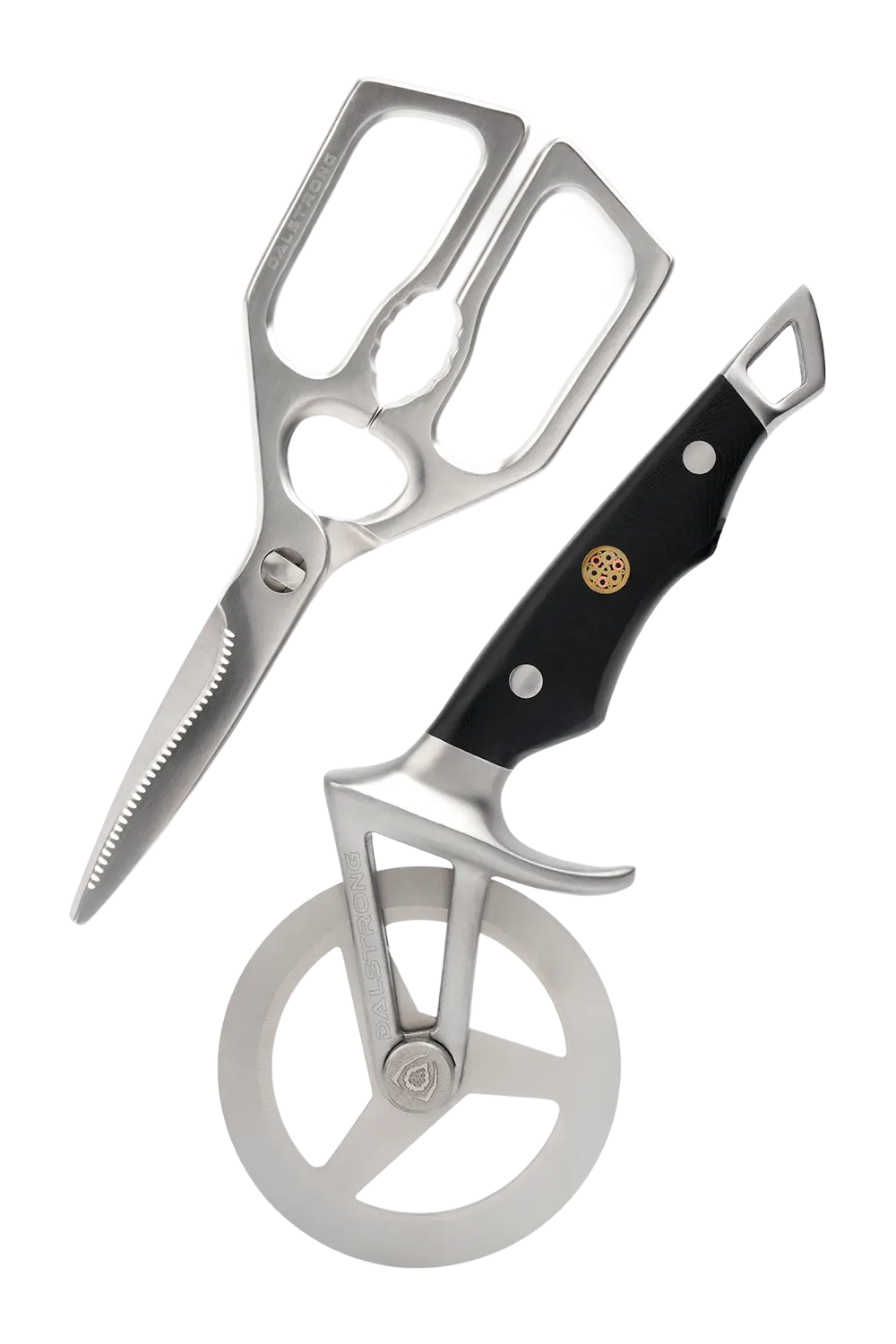



























 Serbian Chef's Knife 8" | Shogun Series | Dalstrong
Serbian Chef's Knife 8" | Shogun Series | Dalstrong


























































































































































































